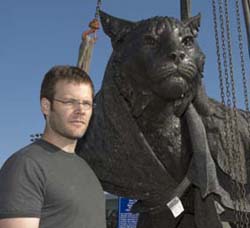 |
 |
| current issue |  |
past issues |  |
send a letter/news |  |
address update |  |
advertise |  |
about us |  |
alumni home |
Campus Currents
Interview with Matthew Gray Palmer, sculptor of the UNH Wildcat
 Matthew Gray Palmer at the installation of the wildcat statue Matthew Gray Palmer at the installation of the wildcat statue
|
What did you use as a model for the wildcat? Did you do some research on what they look like, how they move, etc? What did you learn about the wildcat in the process? Were you concerned with trying to relate the sculpture to the UNH mascot?
Technically, a true wild cat actually looks a great deal like a large house cat. The UNH mascot is more of a mythical creature although its closest relative would be a bobcat. The interest was to create a realistic depiction of an animal, so the challenge was to walk the line between the mythic and making a creature that could actually exist. I combined characteristics of several different large cat species and hinted at some of the attributes of the graphic UNH mascot.
The Wildcat sculpture looks as if it's in motion, with its paw raised, and perhaps about to pounce. What were you trying to convey in the way you positioned the sculpture, the look on its face, and its general appearance?
Because the wildcat is very much associated with athletics it was important to create a powerful dynamic, however, I didn't want it to be overly belligerent but more sleek and graceful, demonstrating agility and balance. I also wanted a strong sense of intelligence within the facial expression and the eyes representing a honed mind equally powerful and cunning to form a more complete symbol of the aims of UNH.
What are the materials that you used to create the sculpture? What is its weight and height? How long did it take you to create it?
The sculpture was first modeled in clay. Once complete a silicon rubber mold was made of the clay sculpture. From this mold a hollow wax recreation of the sculpture was made but left in multiple sections. The sections of the wax recreation were then dipped in a ceramic mold solution that once hardened was super heated to melt the wax out and then accept the molten bronze. The molten bronze filled the voids left by the wax. Once cooled the ceramic molds were blasted away from the hardened bronze. The resulting hollow bronze sections were then welded together to form the wildcat in its entirety. The weld seems were then re-sculpted to match the original texture created in the clay and a patina finish applied to give it its color. The bronze wildcat weighs between 800 and 900 pounds. The granite boulder it is secured to weighs approximately 15,000 pounds. The wildcat's eye level is over 6' high. The sculpting process through foundry took about 10 months.
You created the sculpture in your studio in Washington and then it was fired at a foundry somewhere in the Midwest. How difficult was it to move and transport the sculpture? What did the process entail?
I created the clay sculpture and the silicon molds in my studio in Washington. The foundry work was done at the Crucible in Norman, OK. I drove the wildcat from the foundry to the installation site in a large moving van. We installed it the day that I arrived. Moving the sculpture is not terribly difficult with the proper equipment, just a little nerve racking. We had an excellent crane operator for the installation.
What do you hope that the Wildcat will bring to the campus and mean for the university and its community? How does it feel to have contributed something that is in a sense symbolic of the institution and will be a permanent part of the UNH campus landscape?
I am a firm believer in the value of art in our lives and our surroundings. I hope that the Wildcat will be a source of pride for the UNH community and an opportunity for a wide range of subjective experiences for each individual viewer. I also hope that the success of this project will inspire future opportunities for public art throughout the UNH campus as an acknowledgment of the importance of visual and cultural texture to the university environment. I am extremely honored to have had the opportunity to create the Wildcat for the UNH. It was a true pleasure working with everyone involved in making this project possible. It is humbling to think of how much larger the life and spirit of this symbol will continue to grow for years to come, and I feel very privileged to have been a part of it.
-Kimberly Swick Slover
Return to UNH Magazine Campus Currents
blog comments powered by Disqus

